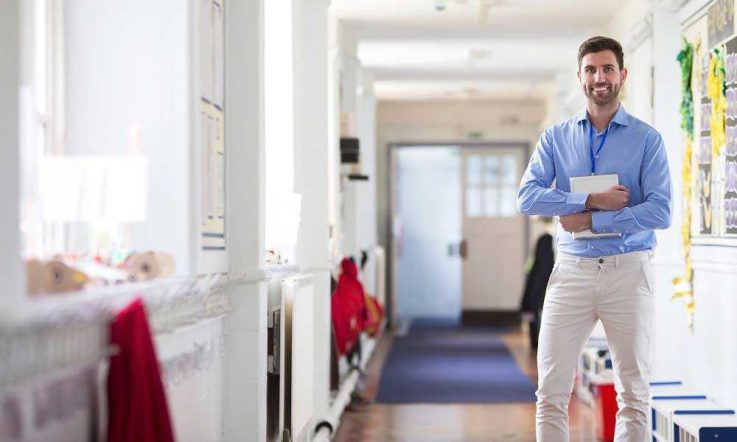Introducing evidence-based programs and interventions is one strategy that can be used by schools to target specific improvements in student outcomes. For Queensland principal Trevor Buchanan, having ongoing support mechanisms for staff is a crucial part of the implementation process.
‘Students in the classrooms have got to have that support to grasp new concepts, to be developed and led through and modelled to,' he tells Teacher. ‘I expect the same from our administration team, that we do the same with our teachers.'
Agnes Water State School has seen improvements in student writing, spelling and vocabulary, and numeracy in recent months, following the introduction of targeted programs. The leadership team says one of the reasons for the success is structured and deliberate implementation, informed by a coaching model started in 2016 called Developing a Shared Understanding of Practice.
The model was put together by Buchanan, Head of Curriculum Leigh Tankey and the school's Master Teacher at the time, Tarnia Doughty. It aligns with the school's pedagogical framework and draws on Robert Marzano's Art and Science of Teaching (ASOT). ‘That's basically where it stemmed from. That gave us our research body and our framework to begin with and it gave us our indicators around teaching success that we wanted to see within our school,' Buchanan says, adding it was something the school had delved into before he was appointed principal in 2015. ‘In 2015 we started looking at and actually using that as a major framework, [and] it was 12 months' worth of work initially around that before we started bringing in the coaching and modelling practice operating in the school now.'
He says the school has copped ‘a bit of flak' for having three priority areas in one year as part of its explicit improvement agenda. ‘Some of the research that comes from Mazarno is that you can run more than one priority and you can run it quite rapidly with a sense of urgency. There were three areas for significant improvement that we saw went hand-in-hand that had to happen, we couldn't wait any longer.'
At the same time, the leadership team was mindful of not overloading teachers by asking them to work on three different areas at the same time. Developing a Shared Understanding of Practice operates on a three term process, where teachers focus on one school priority each term.
Targeted programs in literacy and numeracy
The Seven Steps to Writing Success program was introduced to target improvements in writing, Words their Way was used for spelling, and the school worked with its regional Principal Education Advisor and looked at the research of Alistair McIntosh in the area of numeracy – focusing on areas such as mental computation and warm-ups, and maths games and investigations. Buchanan, Tankey and Doughty took on one priority each and became the ‘expert support' for staff in that area.
‘If we [the leadership team] expect something, we've got to be able to model it, we've got to be able to demonstrate it, we've got to be able to provide the support mechanisms there that go with it,' Buchanan explains. ‘I worked with teachers in one term and we looked just at numeracy – didn't want to see any of their other planning documents for other subject areas, didn't want to worry too much about their practices in those other areas. My focus was for those five teachers at that point in time really around their implementation of numeracy, what they were doing around improvement, how they were tracking their data, what they knew about their kids, what were some of the best practices out there, how to plan effectively around numeracy.'
The process included formal assessment of teaching (again, only in the priority area for that term). However, before reaching that stage, the tables were turned – the leadership team modelled an effective lesson and invited the teachers to use the observational tools on them. ‘So they became very familiar with the observational tool,' Buchanan says. ‘And that observational tool was something we developed from our work around ASOT using a lot of the teacher-level and student-level analysis and all the language that's associated with that.'
In addition to modelling lessons, they took part in collaborative planning and discussion. Towards the end of the term it became an observation and feedback process. ‘Then the following term they would swap and move on to a different priority area. We'd check in on them as the year was going on … so teachers I worked with in Term 1 I'd just check in with them in Term 2 and 3, but there was no formal processes around numeracy with them at that point in time.'
By Term 3, all the teachers had rotated through the three school improvement priority areas. Tankey says, for teachers, the coaching and modelling process was less threatening. ‘It moved more towards a collegial approach where “I'm a peer, I'm a teacher first and foremost …”. They could see me teaching, they could see me stumble over my words, they could see me having to try a few different behaviour management strategies, for example, and so they could relate to me as a teacher.
‘That took away the threat that they were being observed or judged. It was something that we did together. … Through this process we were in there getting our hands dirty with them and making sure that we were accountable for the students' learning as well. So, by the end it wasn't so much “now I'm going to observe you” it was just gathering information, reflecting and talking together.'
Refining the model
This year the process has progressed. Buchanan says the school is still using the same idea and principles, focusing on one priority area at a time, but also Simon Breakspear's work on learning improvement sprints. ‘… now we'll drill right down to even the simplest things around “how do we improve a student's understanding of common fractions using warm-ups?” for example. And we would actually do a sprint around that for a three to four week window – looking at a particular strategy with a particular group of students, looking at their improvement factor, looking at a control group around their performance and [asking] “Does this particular strategy lead to student improvement?” and “Can it be applied across a broader setting?”
‘What happens is that Leigh, myself and our Master Teacher don't necessarily become the experts anymore, we become more of a facilitator and support … bringing in other experts. I think where we were last year, we had enough knowledge base within our staff and leadership team to be able to support that – I think we still do, but it's nice to be able to have that message now coming from other people as well around “this is really good practice within reading, here are some different examples and different ideas”. It gives teachers something fresh to look at and it's a slightly different process to go through, but under the same framework of providing that support.'
Since introducing the three targeted programs and implementation model in 2016, Buchanan says the school has seen: improvements across a range of classes using the NAPLAN writing scale of up to 40 per cent; improvements in spelling using NAPLAN assessment and internal data of up to two years within a 12 month period; and its first spike in NAPLAN numeracy improvement for Years 3 and 5 (the two year groups staff focused on through the program).
He stresses it's not just about the academic, formal data from students. At the end of Term 1 last year, teachers were asked to give their feedback in a survey. They reported enjoying the collegial approach, and that having discussions and problem-solving with other members of staff had reinforced the value of hands-on, inquiry learning in their classroom. ‘Some of them were saying it sharpened their knowledge around the pedagogical framework, why the steps within ASOT were really important and the skillsets that were needed by the students.
‘Even just that confidence level from our teachers and the feedback from them – that was really important for us,' Buchanan reflects.
As a school leader, how do you and your leadership team keep up to date with research on effective teaching practices?
When implementing a program or intervention, what support mechanisms do you put in place for your teachers? How are you monitoring the impact of the programs?



